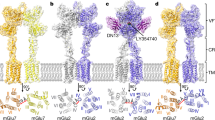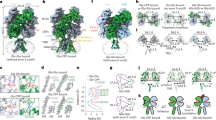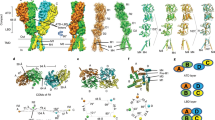Abstract
The amino-terminal domain (ATD) of glutamate receptor ion channels, which controls their selective assembly into AMPA, kainate and NMDA receptor subtypes, is also the site of action of NMDA receptor allosteric modulators. Here we report the crystal structure of the ATD from the kainate receptor GluR6. The ATD forms dimers in solution at micromolar protein concentrations and crystallizes as a dimer. Unexpectedly, each subunit adopts an intermediate extent of domain closure compared to the apo and ligand-bound complexes of LIVBP and G protein–coupled glutamate receptors (mGluRs), and the dimer assembly has a markedly different conformation from that found in mGluRs. This conformation is stabilized by contacts between large hydrophobic patches in the R2 domain that are absent in NMDA receptors, suggesting that the ATDs of individual glutamate receptor ion channels have evolved into functionally distinct families.
This is a preview of subscription content, access via your institution
Access options
Subscribe to this journal
Receive 12 print issues and online access
$189.00 per year
only $15.75 per issue
Buy this article
- Purchase on Springer Link
- Instant access to full article PDF
Prices may be subject to local taxes which are calculated during checkout






Similar content being viewed by others
References
Watkins, J.C. & Evans, R.H. Excitatory amino acid transmitters. Annu. Rev. Pharmacol. Toxicol. 21, 165–204 (1981).
Hollmann, M. Structure of ionotropic glutamate receptors. In Ionotropic Glutamate Receptors in the CNS, Handbook of Experimental Pharmacology Vol. 141 (eds. Jonas, P. & Monyer, H.) 3–98 (Springer, Berlin, 1999).
Pin, J.P., Galvez, T. & Prezeau, L. Evolution, structure, and activation mechanism of family 3/C G-protein-coupled receptors. Pharmacol. Ther. 98, 325–354 (2003).
Nakanishi, N., Shneider, N.A. & Axel, R. A family of glutamate receptor genes: evidence for the formation of heteromultimeric receptors with distinct channel properties. Neuron 5, 569–581 (1990).
Stern-Bach, Y. et al. Agonist-selectivity of glutamate receptors is specified by two domains structurally related to bacterial amino acid binding proteins. Neuron 13, 1345–1357 (1994).
O'Hara, P.J. et al. The ligand-binding domain in metabotropic glutamate receptors is related to bacterial periplasmic binding proteins. Neuron 11, 41–52 (1993).
Kunishima, N. et al. Structural basis of glutamate recognition by a dimeric metabotropic glutamate receptor. Nature 407, 971–977 (2000).
Armstrong, N., Sun, Y., Chen, G.Q. & Gouaux, E. Structure of a glutamate-receptor ligand-binding core in complex with kainate. Nature 395, 913–917 (1998).
Masuko, T. et al. A regulatory domain (R1–R2) in the amino terminus of the N-methyl-D-aspartate receptor: effects of spermine, protons, and ifenprodil, and structural similarity to bacterial leucine/isoleucine/valine binding protein. Mol. Pharmacol. 55, 957–969 (1999).
Paoletti, P. et al. Molecular organization of a zinc binding N-terminal modulatory domain in a NMDA receptor subunit. Neuron 28, 911–925 (2000).
Marinelli, L. et al. Homology modeling of NR2B modulatory domain of NMDA receptor and analysis of ifenprodil binding. Chem. Med. Chem. 2, 1498–1510 (2007).
Mony, L. et al. Structural basis of NR2B-selective antagonist recognition by NMDA receptors. Mol. Pharmacol. 75, 60–74 (2009).
Reeves, P.J., Callewaert, N., Contreras, R. & Khorana, H.G. Structure and function in rhodopsin: high-level expression of rhodopsin with restricted and homogeneous N-glycosylation by a tetracycline-inducible N-acetylglucosaminyltransferase I-negative HEK293S stable mammalian cell line. Proc. Natl. Acad. Sci. USA 99, 13419–13424 (2002).
Kuusinen, A., Abele, R., Madden, D.R. & Keinanen, K. Oligomerization and ligand-binding properties of the ectodomain of the α-amino-3-hydroxy-5-methyl-4-isoxazole propionic acid receptor subunit GluRD. J. Biol. Chem. 274, 28937–28943 (1999).
Wells, G.B., Lin, L., Jeanclos, E.M. & Anand, R. Assembly and ligand binding properties of the water-soluble extracellular domains of the glutamate receptor 1 subunit. J. Biol. Chem. 276, 3031–3036 (2001).
Jin, R. et al. Crystal structure and association behavior of the GluR2 amino terminal domain. EMBO J. (in the press).
Kantardjieff, K.A. & Rupp, B. Matthews coefficient probabilities: improved estimates for unit cell contents of proteins, DNA, and protein-nucleic acid complex crystals. Protein Sci. 12, 1865–1871 (2003).
Mayer, M.L. Crystal Structures of the GluR5 and GluR6 ligand binding cores: molecular mechanisms underlying kainate receptor selectivity. Neuron 45, 539–552 (2005).
Weston, M.C., Schuck, P., Ghosal, A., Rosenmund, C. & Mayer, M.L. Conformational restriction blocks glutamate receptor desensitization. Nat. Struct. Mol. Biol. 13, 1120–1127 (2006).
Muto, T., Tsuchiya, D., Morikawa, K. & Jingami, H. Structures of the extracellular regions of the group II/III metabotropic glutamate receptors. Proc. Natl. Acad. Sci. USA 104, 3759–3764 (2007).
Papadakis, M., Hawkins, L.M. & Stephenson, F.A. Appropriate NR1–NR1 disulfide-linked homodimer formation is requisite for efficient expression of functional, cell surface N-methyl-D-aspartate NR1/NR2 receptors. J. Biol. Chem. 279, 14703–14712 (2004).
Tsuchiya, D., Kunishima, N., Kamiya, N., Jingami, H. & Morikawa, K. Structural views of the ligand-binding cores of a metabotropic glutamate receptor complexed with an antagonist and both glutamate and Gd3+ . Proc. Natl. Acad. Sci. USA 99, 2660–2665 (2002).
Fauchere, J.L. & Pliska, V. Hydrophobic paramete π of amino acid side chains from partitioning of N-acetyl-amino amides. Eur. J. Med. Chem. 18, 369–375 (1983).
Bettler, B. et al. Cloning of a novel glutamate receptor subunit, GluR5: expression in the nervous system during development. Neuron 5, 583–595 (1990).
Nakagawa, T., Cheng, Y., Ramm, E., Sheng, M. & Walz, T. Structure and different conformational states of native AMPA receptor complexes. Nature 433, 545–549 (2005).
Tichelaar, W., Safferling, M., Keinanen, K., Stark, H. & Madden, D.R. The three-dimensional structure of an ionotropic glutamate receptor reveals a dimer-of-dimers assembly. J. Mol. Biol. 344, 435–442 (2004).
Midgett, C.R. & Madden, D.R. The quaternary structure of a calcium-permeable AMPA receptor: conservation of shape and symmetry across functionally distinct subunit assemblies. J. Mol. Biol. 382, 578–584 (2008).
Acher, F.C. & Bertrand, H.O. Amino acid recognition by venus flytrap domains is encoded in an 8-residue motif. Biopolymers 80, 357–366 (2005).
Kniazeff, J., Galvez, T., Labesse, G. & Pin, J.P. No ligand binding in the GB2 subunit of the GABAB receptor is required for activation and allosteric interaction between the subunits. J. Neurosci. 22, 7352–7361 (2002).
Rondard, P. et al. Functioning of the dimeric GABAB receptor extracellular domain revealed by glycan wedge scanning. EMBO J. 27, 1321–1332 (2008).
Gielen, M. et al. Structural rearrangements of NR1/NR2A NMDA receptors during allosteric inhibition. Neuron 57, 80–93 (2008).
Aricescu, A.R., Lu, W. & Jones, E.Y. A time- and cost-efficient system for high-level protein production in mammalian cells. Acta Crystallogr. D Biol. Crystallogr. 62, 1243–1250 (2006).
Otwinowski, Z. & Minor, W. Processing of X-ray diffraction data collected in oscillation mode. Methods Enzymol. 277, 307–326 (1997).
McCoy, A.J. et al. Phaser crystallographic software. J. Appl. Crystallogr. 40, 658–674 (2007).
Adams, P.D. et al. PHENIX: building new software for automated crystallographic structure determination. Acta Crystallogr. D Biol. Crystallogr. 58, 1948–1954 (2002).
Painter, J. & Merritt, E.A. Optimal description of a protein structure in terms of multiple groups undergoing TLS motion. Acta Crystallogr. D Biol. Crystallogr. 62, 439–450 (2006).
Emsley, P. & Cowtan, K. Coot: model-building tools for molecular graphics. Acta Crystallogr. D Biol. Crystallogr. 60, 2126–2132 (2004).
Davis, I.W., Murray, L.W., Richardson, J.S. & Richardson, D.C. MOLPROBITY: structure validation and all-atom contact analysis for nucleic acids and their complexes. Nucleic Acids Res. 32, W615–W619 (2004).
Collaborative Computational Project, Number 4. The CCP4 suite: programs for protein crystallography. Acta Crystallogr. D Biol. Crystallogr. 50, 760–763 (1994).
Kleywegt, G.J., Zou, J.Y., Kjeldgaard, M. & Jones, T.A. Around O. in Crystallography of Biological Macromolecules Vol. F 353–356 (Kluwer Academic, Dordrecht, 2001).
Kraulis, P.J. MOLSCRIPT: a program to produce both detailed and schematic plots of protein structures. J. Appl. Crystallogr. 24, 946–950 (1991).
Landau, M. et al. ConSurf 2005: the projection of evolutionary conservation scores of residues on protein structures. Nucleic Acids Res. 33, W299–W302 (2005).
Brown, P.H., Balbo, A. & Schuck, P. Characterizing protein-protein interactions by sedimentation velocity analytical ultracentrifugation. Curr. Protoc. Immunol. Chapter 18, Unit 18.15 (2008).
Schuck, P. Size-distribution analysis of macromolecules by sedimentation velocity ultracentrifugation and lamm equation modeling. Biophys. J. 78, 1606–1619 (2000).
Schuck, P. On the analysis of protein self-association by sedimentation velocity analytical ultracentrifugation. Anal. Biochem. 320, 104–124 (2003).
García De La Torre, J., Huertas, M.L. & Carrasco, B. Calculation of hydrodynamic properties of globular proteins from their atomic-level structure. Biophys. J. 78, 719–730 (2000).
Balbo, A., Brown, P.H., Braswell, E.H. & Schuck, P. Measuring protein-protein interactions by equilibrium sedimentation. Curr. Protoc. Immunol. Chapter 18, Unit 18.8 (2007).
Vistica, J. et al. Sedimentation equilibrium analysis of protein interactions with global implicit mass conservation constraints and systematic noise decomposition. Anal. Biochem. 326, 234–256 (2004).
Acknowledgements
We thank E. Gouaux for sharing GluR2 ATD coordinates; C. Glasser and A. Balbo for technical assistance; D. Leahy, A. Plested and C. Chaudhry for advice and discussion; P. Seeburg (Max-Planck Institute, Heidelberg) and S. Heinemann (Salk Institute) for the gift of the wild-type iGluR plasmids; S. Hansen and P. Reeves (Massachusetts Institute of Technology) for the gift of GnTI− cells; H. Jaffe (Protein/Peptide Sequencing Facility, US National Institute of Neurological Disorders and Stroke (NINDS)) for performing MS analysis and N-terminal sequencing; T. Kawate and E. Gouaux (Vollum Institute) for the gift of Endo H and PNGase F clones; P. Paoletti for providing coordinates for NR2A and NR2B ATD models; and J. Garcia de la Torre (University of Murcia) for the program HYDROPRO. Nucleic acid sequencing was performed by the NINDS DNA sequencing facility. Synchrotron diffraction data was collected at Southeast Regional Collaborative Access Team (SER-CAT) 22-ID beamline at the Advanced Photon Source, Argonne National Laboratory. Use of the Advanced Photon Source was supported by the US Department of Energy, Office of Science, Office of Basic Energy Sciences, under Contract No. W-31-109-Eng-38. This work was supported by the intramural research program of the US National Institute of Child Health and Human Development, National Institutes of Health, Department of Health and Human Services (M.L.M.).
Author information
Authors and Affiliations
Contributions
J.K. performed biochemistry and structural biology experiments; P.S. performed analytical ultracentrifugation; M.L.M. assisted with data collection, structure solution and analysis; R.J. solved the GluR2 structure used for molecular replacement; all authors contributed to data analysis and interpretation.
Corresponding author
Supplementary information
Supplementary Text and Figures
Supplementary Figures 1–6, Supplementary Methods and Supplementary Results (PDF 20697 kb)
Supplementary Movie 1
The initial view shows a GluR6 ATD dimer with the N-terminus facing the viewer and the molecular surface of the two protomers shaded blue and red; following rotation by 90° to show a side view, the movie pauses to show the 20° tilt of each subunit about the vertical axis. Next, the surface is colored by electrostatic potential contoured ± 5 kT/e calculated with APBS, and the view rotated by 180° to illustrate the rough solvent exposed polar surface of the GluR6 ATD dimer. The rear subunit is then removed and the view rotated by 180° to illustrate the smooth and non polar surface of the dimer interface in domains R1 and especially R2. The view then rotates to show the lateral edge of domain R1 which contains a cation binding site with a bound cation drawn as a yellow sphere. (MOV 4480 kb)
Rights and permissions
About this article
Cite this article
Kumar, J., Schuck, P., Jin, R. et al. The N-terminal domain of GluR6-subtype glutamate receptor ion channels. Nat Struct Mol Biol 16, 631–638 (2009). https://doi.org/10.1038/nsmb.1613
Received:
Accepted:
Published:
Issue Date:
DOI: https://doi.org/10.1038/nsmb.1613
This article is cited by
-
Taste substance binding elicits conformational change of taste receptor T1r heterodimer extracellular domains
Scientific Reports (2016)
-
Probing Intersubunit Interfaces in AMPA-subtype Ionotropic Glutamate Receptors
Scientific Reports (2016)
-
NMDA receptor structures reveal subunit arrangement and pore architecture
Nature (2014)
-
Allosteric signaling and dynamics of the clamshell-like NMDA receptor GluN1 N-terminal domain
Nature Structural & Molecular Biology (2013)
-
Structural mechanism of ligand activation in human GABAB receptor
Nature (2013)



